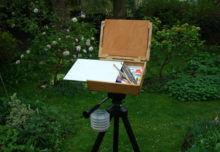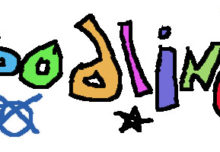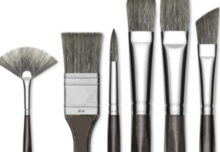Titles and Labels for Paintings and Prints
So, if you are an artist, what do you call your paintings? Do you find it easy to provide the titles or not?
My guess based on 50 years at the studio coal-face is that most artists find it quite tricky to know the best thing to do. Especially now that we have computers, and the Internet with search engines.
This is how those two factors have changed everything.
Computers.
A prolific professional artist can amass a library of thousands of pieces of artwork over their career. In the good old days before computers, we had to take film-camera photos, take a roll of them down to the chemists, pay money to get the roll processed, then wait a week or longer, write a page in a loose leafed folder, and start the record for each piece of our work. So for a lot of smaller works we didn’t. That is if we were any good at all of running our self contained small business. Many of us were not.
And we didn’t foresee the future either. Silly us. So we didn’t keep the sort of records that are needed now that we do have computers. Computers can store data in various forms. Pictures, titles, media details, dates, location, history, and lots more.
Your computer can provide and use spread-sheets with huge capacity, including storage for images and links. It can design websites, and selling carts, accounting programmes, it can copy and paste, and more.
Your cell phone.
The little computer in your mobile phone can take many photos of your artwork. Not just the finished stage either. But bit-by-bit as it goes from blank canvas to finished framed product. It can even make a video of you doing it. The computer knows the date all by itself. It does it instantly and you don’t have to pay extra.
And you can search for any individual item or get a list of similar. It can all be rather efficient. Because computers can search vast data-file records to find dates, customers, titles, etc.
And you can share on the Internet. The title or other label on a piece can be quite crucial here.
Internet.
The Internet with social media, web shops, and your own website is a major influence for the title or label.
Remember that Google can read words but cannot, at the moment, recognize images as well as human eyes can. So we have to provide the words.
Other people can search for the words but cannot input an image that they see in their minds eye.
So the words in the title or label are crucial.
About half the people who will look at your artwork on the Internet will have searched and the other half will have stumbled across it.
The stumblers are potential collectors who will just be browsing and will have discovered your work because it is linked somehow to their previous page.
Another factor about the Internet is that it is gradually replacing traditional gallery bricks and mortar venues. Many good galleries have closed down, while others are surviving by increasing their business product offering on the Internet.
Artists need to provide work that can be found, seen, and sold from a website even if they still use third-party gatekeeper art dealers to do the selling.
Best practice for titles and labels.
It used to be OK to call your work something like ‘Still Life 3rd May’, or ‘Landscape Scotland’.
Nice short titles. If you make prints it is succinct so not much writing in pencil along the bottom margin of the print.
But no-one is going to search on ‘Still Life 3rd May’ because that could be anything. Instead, if they have something in mind, they might search on ‘work by Joe Bloggs in Spring 2018 with fruit’.
So can we improve our title making practice to get the best from Google, human searchers, art dealers, galleries, auction houses, and stumblers?
Yes we can.
Every picture or image on the Internet has a hidden layer or two of text. The title and alt text information is where we should be concentrating. So every image should include alt text info saying things like ‘by artist Colin Ruffell’. [That’s me by the way so change yours to your name please.] Then the title that will be listed in catalogues or written along the bottom of a print. Plus a date, and media details like ‘original acrylic on gesso panel’ or whatever.
You can see that the title part can still be succinct and simple. But if you wanted to you could add more detail to the computer record such as a statement or link to even more information about you, your method, inspiration etc.
When you write your title you are stuck with it. Especially if it is a print in an edition. But you can always change and update the alt information.
Conclusion.
In the real world many artists are still surviving and even thriving without using computers or the Internet in their work practice.
They show their work in real life settings like exhibitions or open studios. Or they supply real art galleries or shops with actual finished product.
Just like the old days. They can still use very simple titles.
But they should be aware that the future is going to be different.
At the very least they must take photos using digital cameras. Then store these with details such as date and history.
If they do seek recognition or sales on the Internet then they should, must, include text and alt text with their images that Google can read.
Titles and labels are crucial.
Onward and upward into the future.
*****************************************************





